Social tenants in Scotland 2017
Overview of social tenants and social rented housing in Scotland for 2017, covering information on stock, households, housing flows, rents and income.
Section 4 - Housing Flows
4.1 Social housing lets
Chart 4.1 below shows the number of social rented housing lets in Scotland each year from 2013/14 to 2017/18. In 2017/18 there were a total of 53,629 social rented housing lets, an increase of 678 lets, or 1%, on the 52,924 lets in 2016/17. This was due to an increase in housing association lets (up by 827, or 3%) whilst local authority lets dropped by 122, or 0.5%).
Lets have fallen by 7% between 2013/14 to 2017/18, with local authority lets falling by 11% and housing association lets dropping by 3%.
The number of lets figures presented exclude any mutual exchanges, which is when two tenants who both live in the social sector agree to exchange homes and tenancies. There were a total of 3,344 social sector mutual exchanges in 2017/18 (Scottish Housing Regulator Charter data), which equates to around 6% of all social housing lets in that year.
The percentage split of the number of lets by local authorities and housing associations has diverged slightly over the last five years. In both 2013/14 and 2014/15, 50% of lets were by local authorities and 50% by housing associations. This has changed to 48% of lets from local authorities and 52% from housing associations in 2017/18. This is despite local authorities having 53% of all social rented housing stock as at March 2017.
Chart 4.1: Number of social housing lets per year, 2013/14 to 2017/18
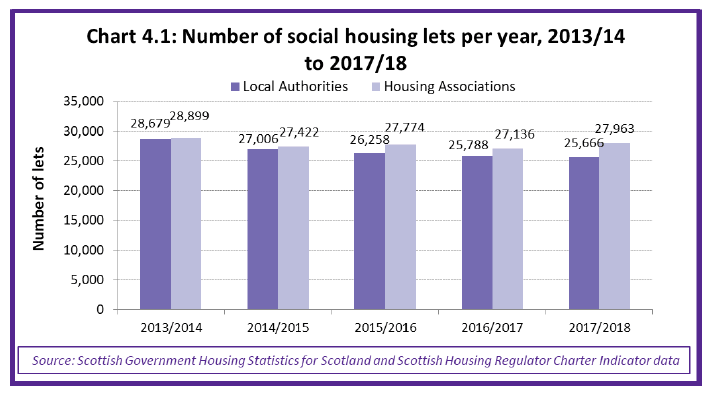
4.2 Lets by source category
The proportion of social housing lets to housing list applicants (note that this figure excludes existing tenants who were on a housing list) has remained fairly constant over the last four years from 2013/14 to 2017/18, with 44% of all social housing lets during 2017/18 being to this type of applicant, similar to the figure of 44% seen in 2013/14. The proportion of lets to existing tenants has fallen from 21% in 2013/14 to 18% in 2017/18. Whilst the percentage of lets to homeless applicants has increased from 30% in 2013/14 to 34% in 2017/18.
Chart 4.2: Percentage of social housing lets during the reporting year by source of let , 2013/14 to 2017/18
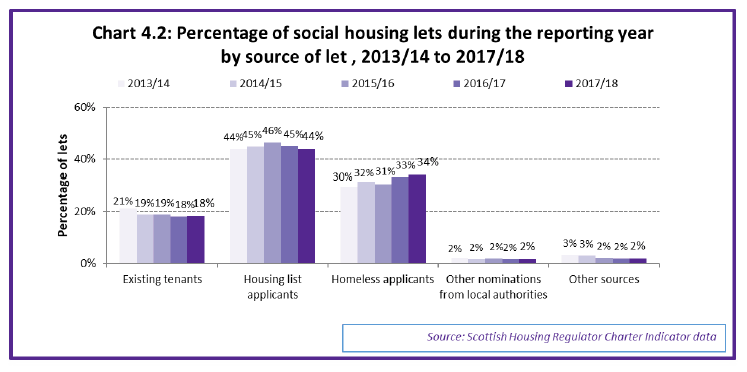
There are some differences in the proportion of lets by source category between local authorities and housing associations. In 2017/18, 35% of lets by local authorities were to housing list applicants (where applicants were not already existing tenants), 43% were to homeless applicants and 22% were to existing tenants. This compares to 52% of lets by housing associations being to housing list applicants, 15% being to existing tenants and 26% being as a result of homeless applicants.
Homeless applicants apply to a local authority to be assessed and if they are assessed as statutorily homeless or potentially homeless then the local authority has a legal duty to provide permanent housing. They may then be nominated to a housing association to be housed. If the housing association is not able to provide permanent housing within six weeks it can decline the nomination. The percentage of accepted housing nominations for homeless applicants is shown in Chart 4.4 below in the category "homeless applicants". Nominations to housing associations from local authorities for reasons other than homelessness are counted in the category "other nominations from local authorities".
Chart 4.3: Percentage of local authority lets during the reporting year by source of let, 2013/14 to 2017/18
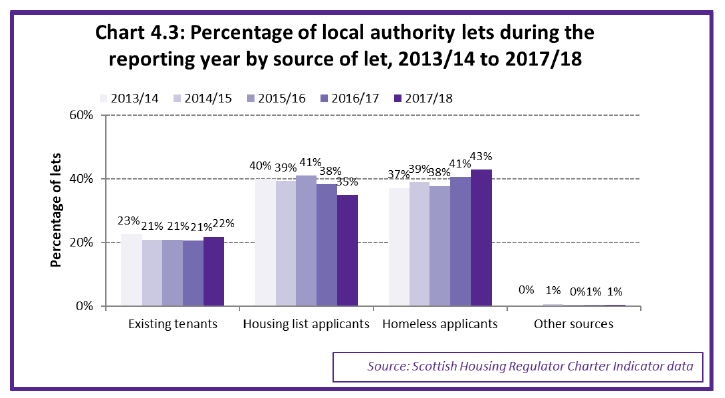
Chart 4.4: Percentage of housing association lets during the reporting year by source of let, 2013/14 to 2017/18
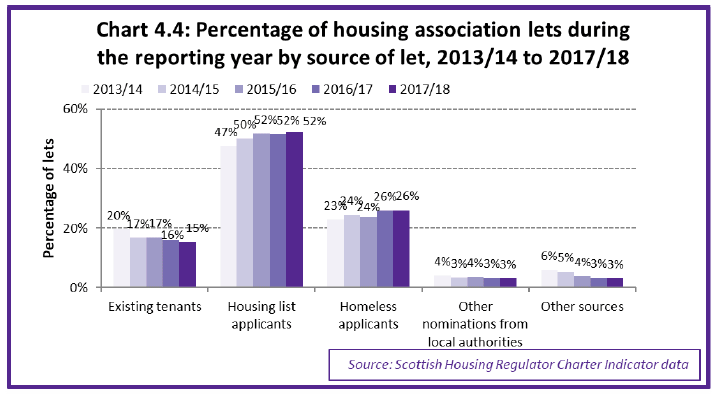
It should be noted that behind these Scotland level figures, source of lets are likely to vary widely by provider and across regions of the country, and there will be a range of factors affecting the source of lets, including the different range of client groups that each landlord is supporting. Information on the number of different types of lets by each landlord is published by the Scottish Housing Regulator as part of the range of financial and performance information collected from social landlords to help monitor performance against the standards and outcomes of the Scottish Social Housing Charter[27].
The level of new intake into social housing during a reporting year can be calculated by adding up the social rented housing lets from all sources but excluding those to existing tenants and mutual exchanges. In 2017/18, the total number of new intake lets by local authorities was 20,296, equating to 79% of all local authority lets. In the same year there were 23,652 new intake lets by housing associations, equating to 85% of all housing association lets.
4.3 General needs and supported housing lets
The majority of social rented housing lets in the last four years have been for general needs housing. In 2017/18, 86% of all lets were general needs lets. Split by provider, 90% of local authority lets and 82% of housing association lets were general needs lets. The proportions of general needs lets decreased slightly over the four years from 2013/14 to 2017/18 for both local authority lets and housing association lets (from 91% to 90% and from 86% to 82%, respectively), with the proportions of supported housing lets increasing over the same period (from 9% to 10% for local authority lets and from 14% to 18% for housing association lets).
In 2017/18, 10% of local authority lets and 18% of housing association lets were related to supported housing. The number of supported housing lets is based on the type of property that the let involves. It does not measure the number of people with supported housing needs. Supported housing includes sheltered or very sheltered housing, medium dependency housing, wheelchair housing, ambulant disabled and other specially adapted housing.
Chart 4.5: Number of lets during reporting year, by general needs and supported housing, 2013/14 to 2017/18
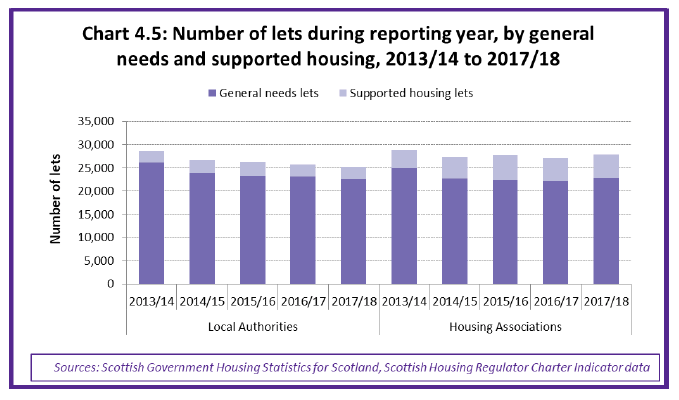
It should be noted that behind these Scotland level figures provision of supported housing is likely to vary widely by provider and across regions of the country, and there will be a range of factors affecting the provision and use of supported housing, including the different range of client groups that each landlord is supporting. Information on the number of different types of lets by each landlord is published by the Scottish Housing Regulator as part of the range of financial and performance information collected from social landlords to help monitor performance against the standards and outcomes of the Scottish Social Housing Charter[28].
4.4 Length of time at current address
Social rented households in Scotland in 2017 had been at their current address for an average of 11 years, a slightly shorter average time than in 1999 (12 years). In 2017, 18% of social renters had been at their address for between one and two years, an increase compared to 13% in 1999. In 2017, 16% of social renters had been at their current address for over 20 years, a drop from 20% in 1999.
Chart 4.6: Length of time at current address of social renters (random adult in household), 1999, 2008 and 2017
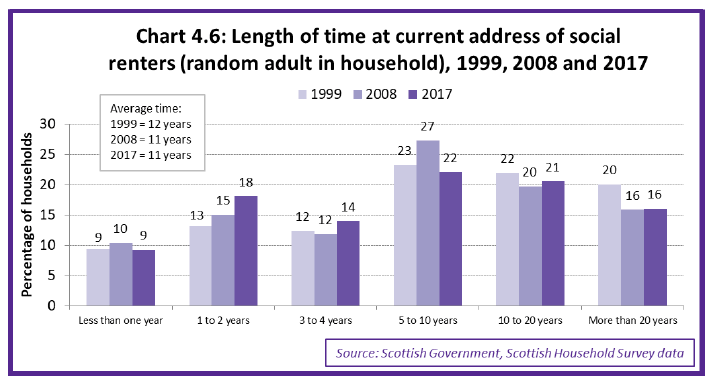
Housing association households in 2017 had been at their address for an average time of 10 years, less than the average time of 12 years for local authority households. Only 11% of housing association households had been resident at their address for over 20 years, compared with 20% of local authority households.
Chart 4.7: Length of time at current address of social renters (random adult in household), 2017, by social landlord
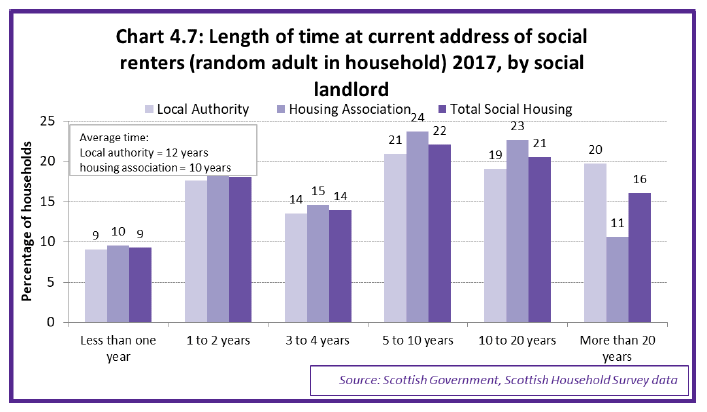
Chart 4.8 below shows the average length of time at their current address of social renters between 2013 and 2017. The percentage who had been at their current address for less than one year ranged from 8% in East Renfrewshire to 17% in the Scottish Borders and Dundee City. The percentage of adults who had been at their address for more than 10 years ranged from 26% in Orkney Islands to 46% in Midlothian.
Chart 4.8: Length of time at current address (random adult in household), 2013 to 2017, by local authority
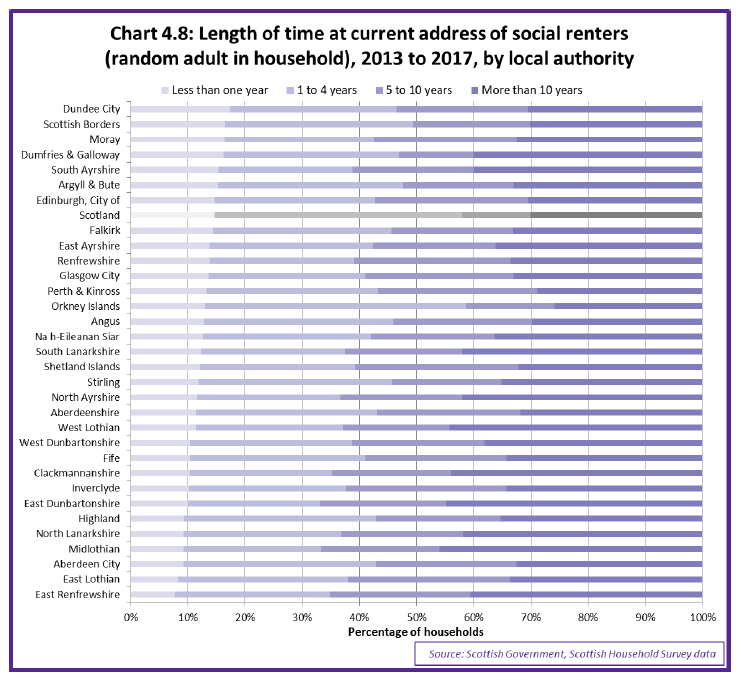
Note: survey data from the four years from 2013 to 2017 has been combined together to provide a sufficient sample size to allow a local authority level analysis. However local authority sample sizes across these four years vary from 130 in East Renfrewshire up to 1,530 in Glasgow City, and so there will be larger margins of error for some local authorities than others. As such some differences between local authorities should be treated with caution, as these might reflect sampling variation rather than real changes.
Households in other tenures showed different patterns of length of tenure in 2017. Private rented households had on average been at their address for only 4 years, with 35% of households having been at their address for less than one year. Households who were buying with a mortgage had on average been at their address for 10 years, with 27% having been at their property for between 10 and 20 years. Households who owned outright had on average been living at their property for 22 years, with 51% having lived at their address for over 20 years.
Chart 4.9: Length of time at current address (random adult in household), 2017, by tenure
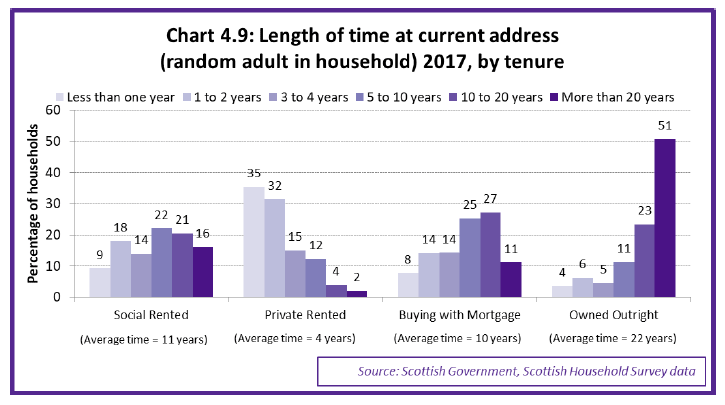
4.5 Vacant normal letting stock
The Scottish Housing Regulator collects Charter Indicator data on the amount of vacant normal letting stock (also referred to as "voids"). The vacant period commences on the first day that there is no rent debit and ends the day before a new rent debit is raised. Some empty properties are not included in the count of vacant dwellings, for example properties that are going to be demolished or are awaiting or undergoing a modernisation project.
Chart 4.10 below shows the number of normal letting stock vacant properties in Scotland as at the end of March each year from 2013/14 to 2017/18, split by local authorities and housing associations. There were 6,053 normal letting stock vacant properties at the end of 2017/18, an increase of 722 properties, or 16%, on the 5,331 vacant properties as at end of 2016/17. The 6,053 vacant properties represents 1.1% of all lettable stock, a slight increase from 0.9% in the previous year.
The amount of stock vacant for more than 6 months provides an indication of how many properties are vacant for more prolonged periods of time. Out of the vacant normal social housing letting stock at the end of 2017/18, 7% had been vacant for more than 6 months, a total of 458 properties which is a drop of 206 or 31% on the previous year. Normal letting stock vacant for more than 6 months equates to 0.1% of total lettable stock.
Chart 4.10: Vacant normal dwelling stock - number of units
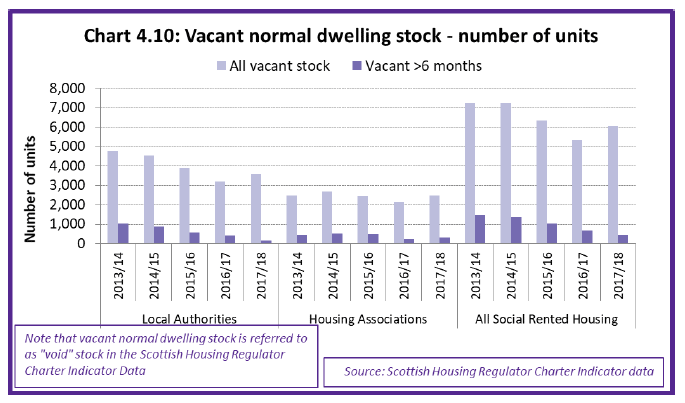
4.6 Length of time properties are empty before being let
Chart 4.11 below shows the average number of calendar days that a property was empty for before being re-let.
Local authority properties were on average empty for 34.3 calendar days before being re-let in 2017/18, which is lower than the figure for 2016/17 (36.0 days), as well as the averages for the earlier years 2013/14 to 2015/16.
Housing association properties were on average empty a shorter period of time than local authority dwellings. Housing association properties were on average empty for 27.2 calendar days before being re-let in 2017/18, a figure slightly higher than in 2016/17 (26.8 days), but lower than averages for the earlier years 2013/14 to 2015/16.
Chart 4.11: Average number of calendar days property was empty for before re-let
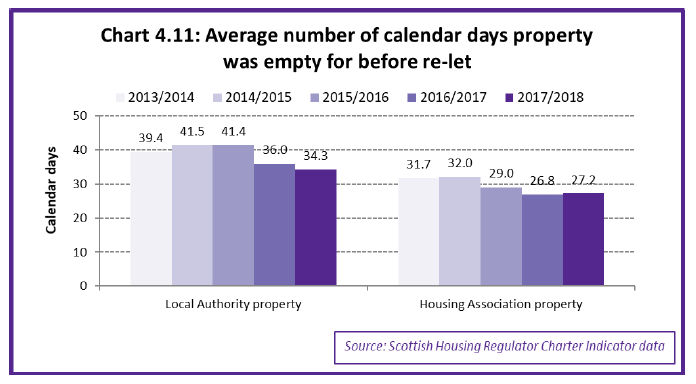
4.7 Adults at social housing addresses for less than one year - Tenure of previous address
When looking at social rented households in Scotland in which an adult had moved into the address within the last 12 months in 2017 (which includes new-lets as well as changes to existing household compositions), almost half of adults (45%) had a previous address which was also social rented, 22% had a previous address that was rented privately and 21% had a previous address that was their parental/family home.
Chart 4.12: Adults who have moved into social rented households in the last 12 months: previous tenure
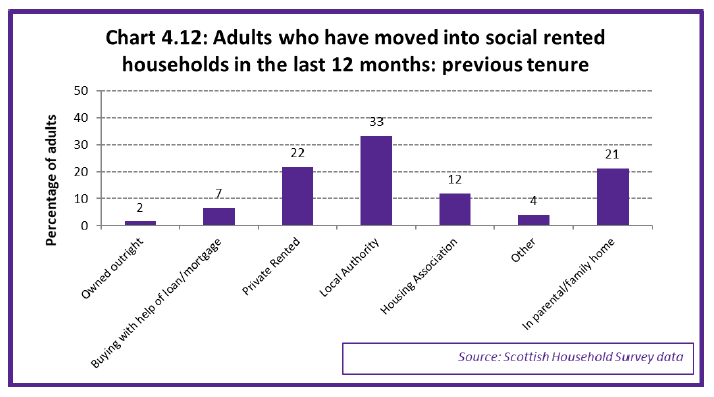
Applying these figures to the estimated 80,000 adults who moved into social housing in 2017, it is estimated that 40,000 adults moved into a social rented household from another social rented address, 20,000 adults moved into social housing from their parental/family home, and 20,000 adults moved into social housing from a private rented property.
Note that these are broad estimates only, given the sample sizes used in the analysis, and therefore have been rounded to the nearest 10,000 to reflect this.
4.8 Reasons for moving to local area
The Scottish Household Survey asks respondents to select their main reasons for moving to their local area from a given list of suggested answers. Note that this question is asked of respondents no matter how long they have been living at their address for. The following analysis covers the most common four reasons selected by social rented households.
The most common reason given in 2017 by 30% of social rented households was that that they had moved to their local area for the right size or kind of property (27%). Social rented households in 2017 also said they had moved to their local area because of a change in family or household circumstances or due to leaving home (26%), to be near family or friends (12%), and because they had no choice for example being allocated by social housing providers or due to eviction (11%).
Chart 4.13: Main reasons for moving to area - social rented households, 2013 to 2017
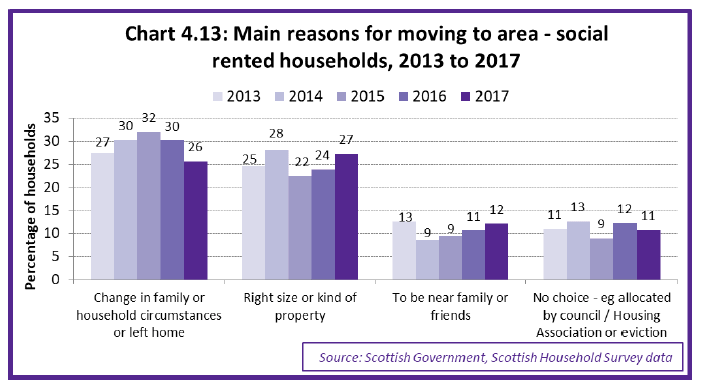
Housing Association households in 2017 were slightly more likely to have stated that they had moved to their area for the right size or kind of property (32%) than Local Authority households (25%).
Chart 4.14: Main reason for moving to area - social rented households, 2017, by landlord
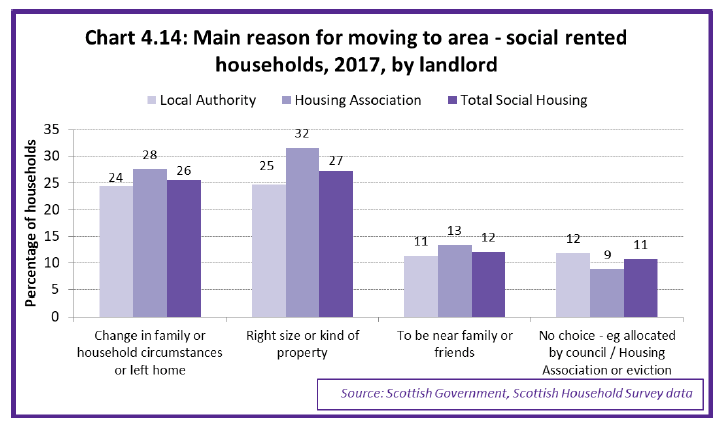
Households buying with mortgage (38%) and owned outright (37%) were more likely to have stated that they moved to their area for the right size or kind of property than social rented households (27%) or private rented households (19%).
Chart 4.15: Main reason for moving to area, 2017, by tenure
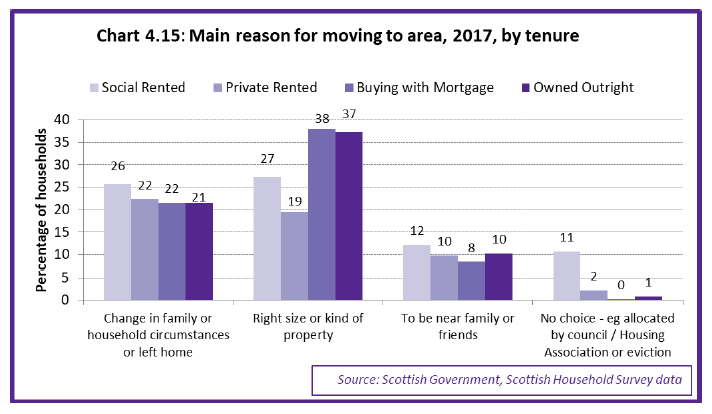
When looking at social rented households in Scotland in which an adult has moved into the address within the last 12 months (which includes new-lets as well as changes to existing household compositions), there were similar percentages stating the four main reasons for moving when compared to all social rented households. This would suggest that there is little difference in the reasons for moving to the local area between newly formed households and more established households.
Chart 4.16: Social rented households - main reason for moving to area - where an adult has moved into the address within the last 12 months, 2013 to 2017
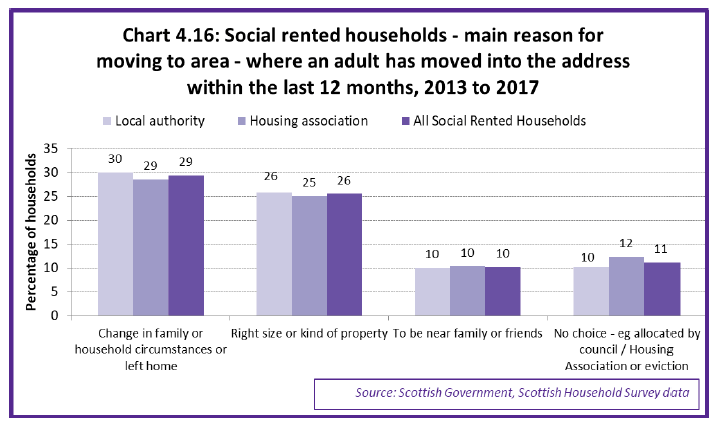
Contact
There is a problem
Thanks for your feedback